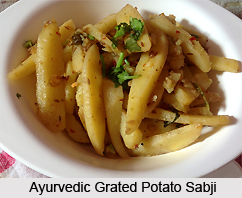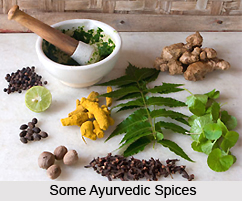 Ayurvedic grated potato sabji is a vegetable dish which is usually consumed by teaming up with main meal. The basic ingredients for making this preparation are potatoes, oil, salt and some spices. This dish provides myriad health benefits. It is easy to cook and can be made at home.
Ayurvedic grated potato sabji is a vegetable dish which is usually consumed by teaming up with main meal. The basic ingredients for making this preparation are potatoes, oil, salt and some spices. This dish provides myriad health benefits. It is easy to cook and can be made at home.
Ingredients of Ayurvedic Grated Potato Sabji
•Two tablespoon of safflower oil
•Four cups of white potatoes
•Half teaspoon of black mustard seeds
•Half teaspoon of cumin seeds
•A pinch of hing
•Half teaspoon of turmeric
•Half green chilli chopped
•One-fourth teaspoon of ajwain
•One-fourth teaspoon of salt
Method of Preparing Ayurvedic Grated Potato Sabji
•Wash, peel and grate the potatoes. After washing two to three times drain the water.
•Heat a deep frying pan on medium heat and then add oil, mustard seeds, cumin seeds and hing.
•Wait till the seeds pop; add the chilli, turmeric and ajwain followed by salt. Stir and add the potatoes and mix well so that the spices coat well on the potatoes.
•Lower the flame and cover and cook for at least five minutes. Stir and cook for another five minutes. It has to be cooked till it softens and gets together.
•Serve.
 Benefits of Ayurvedic Grated Potato Sabji
Benefits of Ayurvedic Grated Potato Sabji
All the ingredients used in this preparation are loaded with different vitamins and proteins that are good for the health. The hing, chilli and ajwain in this particular Ayurvedic Grated potato subji help to reduce the Vata dosha aggravating qualities, of the potatoes. The preparation increases the digestive power, and Pitta prakriti person should eat carefully.
Safflower seed oil contains linolenic and linoleic acids which might help lower cholesterol, and reduce the risk of heart disease. Black mustard seeds encourage perspiration, improve digestion, open the lungs and sinuses, and heal the skin. Cumin is enriched with iron, manganese, and other vitamins and minerals. Cumin stimulates the production of pancreatic enzymes and helps digestion.
Turmeric ensures innumerable health benefits like it improves digestion, prevents liver disease, prevents cancer, reduces cholesterol level, heal wound, and controls diabetes. And lastly green chilli, besides adding a unique flavour and taste to the meals, it plays a key role in absorption of other vitamins in the body. Thus, it can be said that moderate consumption of Ayurvedic Grated Potato Sabji on a regular basis can be of great help.




















